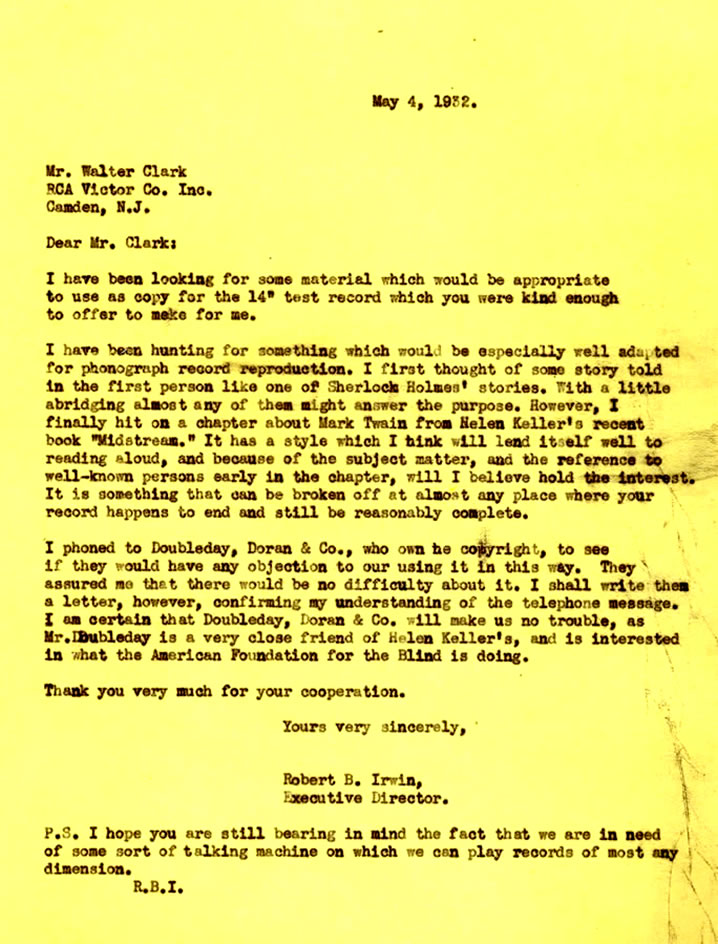Letter from Robert B. Irwin, Executive Director at the American Foundation for the Blind to Walter Clark at RCA Victor Company, suggesting they use a chapter about Mark Twain from Helen Keller's book Midstream for a test recording. May 4, 1932. Talking Book Archives, American Foundation for the Blind.
In the late 1920s, AFB approached commercial recording companies that were developing better methods of recording the spoken word. AFB wanted a commercial firm to manufacture books on records for blind individuals. However, it was unprofitable for commercial companies to produce such a small quantity of records. Therefore, AFB decided to manufacture the records itself, although it had never initially intended to do so.
In 1932, as a result of funding from the Carnegie Corporation and a benefactor, Mrs. William H. Moore, AFB launched a two-year research program in sound recording for the express purpose of providing Talking Books and Talking Book machines to men and women with vision loss.
In that same year, AFB hired Jackson O. Kleber, a former electrical engineer at the recording laboratories of RCA Victor. Kleber's expertise was needed to solve two major obstacles in the path towards making Talking Books available. Could a record be manufactured that would be affordable to the average person who was blind? And if so, what material would produce records durable enough to be shipped repeatedly?
The outcome of this research and development effort was a 12-inch 33 1/3 rpm disc made out of a synthetic material called Vinylite. The disc was both durable and flexible and therefore suitable for transporting. It had many more grooves per inch than the traditional 78 rpm record and rotated at a far slower speed, allowing for larger amounts of material to be stored on a single side. Regarding the development of a "reproducer" as the Talking Book machines were called, AFB devised two—one electric, the other spring-driven. The former cost approximately thirty dollars and the latter, designed for those without access to electricity, cost twenty dollars.
Although commercial recording firms were not directly involved in the manufacture of records for blind individuals, their knowledge and technological expertise were invaluable to the production of Talking Books. RCA produced test recordings for AFB, including a chapter from Helen Keller's book Midstream (1932) and The Raven by Edgar Allen Poe (1933).
Full Text of Letter
May 4, 1932
Mr. Walter Clark
RCA Victor Co. Inc.
Camden, N.J.
Dear Mr. Clark:
I have been looking for some material which would be appropriate to use as copy for the 14" test record which you were kind enough to offer to make for me.
I have been hunting for something which would be especially well adapted for phonograph record reproduction. I first thought of some story told in the first person like one of Sherlock Holmes' stories. With a little abridging almost any of them might answer the purpose. However, I finally hit on a chapter about Mark Twain from Helen Keller's recent book, "Midstream." It has a style which I think will lend itself well to reading aloud, and because of the subject matter, and the reference to well-known persons early in the chapter, will I believe hold the interest. It is something that can be broken off at almost any place where your record happens to end and still be reasonably complete.
I phoned to Doubleday, Doran & Co., who own the copyright, to see if they would have any objection to our using it in this way. They assured me that there would be no difficulty about it. I shall write them a letter, however, confirming my understanding of the telephone message. I am certain that Doubleday, Doran & Co. will make us no trouble as Mr. Doubleday is a very close friend of Helen Keller's, and is interested in what the American Foundation for the Blind is doing.
Thank you very much for your cooperation.
Yours very sincerely,
Robert B. Irwin,
Executive Director.
P.S. I hope you are still bearing in mind the fact that we are in need of some sort of talking machine on which we can play records of most any dimension.
R.B.I
